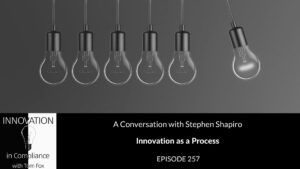
Tom Fox asks Stephen Shapiro what makes him so passionate about innovation. He replies, “It is the key for economic growth for companies, for individuals and society.” Twenty-five years ago, Stephen launched a successful innovation practice at Accenture that focused on value creation and growth. He left Accenture in 2001, but his ongoing work is still all about innovation. Tom Fox welcomes him to this week’s show to discuss his patented FAST innovation process.
FAST Innovation
Tom asks Stephen to describe his FAST innovation approach. Processes need to be repeatable and predictable, Stephen says. FAST stands for Focus, Ask, Shift and Test. People usually think of the mass production of ideas and suggestions when they think about innovation. However, true innovation requires you to determine where to focus your limited energy and resources on what is most important. Then, ask more goal-specific questions that would enable you to deliver better solutions. Finally, test these solutions to bring them to market. Tom remarks that every CCO needs to learn this approach because it’s exactly what must be done in a compliance innovation process. “A good process should help you do something important more efficiently and be able to scale that throughout the organization,” he comments.
Culture of Innovation
How do you build a culture of innovation, Tom asks Stephen. How did you build it in a massive company like Accenture? Culture is important because that becomes the norms, beliefs, and behaviors that people take on, Stephen replies. Most companies are on one of three levels: they see innovation either as an event, a process, or a system. A culture of innovation allows employees to work more flexibly as they know the rules and how to execute them seamlessly.
This is how they built a culture of innovation at Accenture. Stephen states that innovation is about relevance and ensuring that the right products and services are being offered to the right consumers. He sees this as the senior leaders’ mandate. He and Tom discuss the role of the board of directors in creating a culture of innovation.
Asking Better Questions
“Innovation isn’t about the idea, it’s not about the solution; it’s actually about the value it ultimately creates,” Stephen tells listeners. He is passionate about creating something of value and then selling it in a way that people become excited about it. He tells Tom about the books he authored and highlights key takeaways from his recent book Invisible Solutions. The book is based on a tool that Stephen developed; “its purpose is to help people stop looking for answers and to look for better questions,” he remarks. The process of reframing allows you to look at the problem from a different angle. Better questions lead to better solutions. Tom asks why framing the question correctly is so important in the innovation process. Stephen says that our past decisions and experiences influence how we approach innovation. We have to overcome these biases because they limit our ability to see a new and better future. Reframing questions allows us to access new answers.
Talent Acquisition and Retention
Stephen’s white paper, How We Created a 20,000-Person Culture of Innovation at Accenture… and You Can Do It Too, advocates training masters and having them push the innovation message throughout the organization. Innovation -and compliance- has to be for people by people, Tom and Stephen agree. Hiring strategy is part and parcel of this. Hire for divergent thinking, Stephen advises. “People have different perspectives, different experiences, different personalities and when we embrace that and appreciate what each person brings to the table, then we can create a powerful culture of innovation.” If your company creates a culture of innovation with strong values, you’ll attract and keep top-level talent. People prefer to work at companies where it feels like their work matters and their individual, unique talents are recognized and appreciated. They want to work for companies where they are evaluated based on their skill set and are rewarded appropriately.
Resources
Stephen Shapiro | LinkedIn | Twitter
Website | Personality Poker | Invisible Solutions
White Paper: How We Created a 20,000-Person Culture of Innovation at Accenture… and You Can Do It Too


